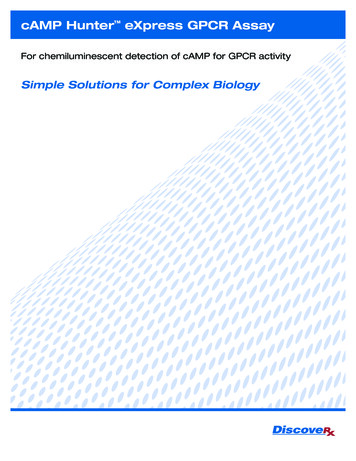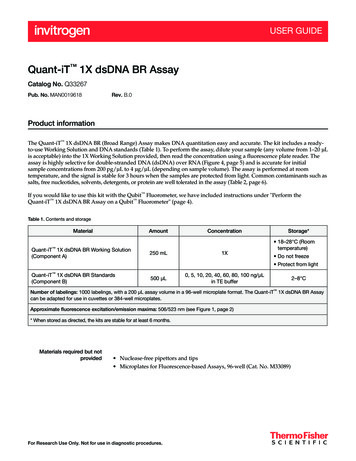
Transcription
A P P L I C AT I O N N O T EAlpha TechnologyAuthor:Adam CarlsonPerkinElmer, Inc.Hopkinton, MAcAMP Assay Provides Flexibilityand Stable PharmacologyIntroductionG protein-coupled receptors (GPCRs)are the largest and most diverseprotein family in the human genomewith over 800 members identified to date. They play a role in cellular and physiological processesincluding cell proliferation, differentiation, neurotransmission, development, and apoptosis.1GPCRs are cell surface transmembrane receptors that catalyze the activation of G-proteins. Theycouple to three main families of Gα subunits: Gαi/o, Gαs, and Gαq. Gαs subunits activateadenylate cyclase, while Gαi subunits inhibit adenylate cyclase. Adenylate cyclase is an enzymethat catalyzes the conversion of adenosine triphosphate (ATP) to cyclic adenosine monophosphate(cAMP). Acting as a second messenger, cAMP is used for intracellular signal transduction in avariety of biological processes including cell growth and differentiation, gene transcription, andprotein expression.2 GPCR activity for the subunits Gαs and Gαi is commonly assessed bymeasuring levels of intracellular cAMP upon stimulation by agonists. Abnormal GPCR activity isrelated to many disease states such as cancer and therefore GPCRs have been an important classof pharmaceutical drug targets.3 Multiple assay formats have been developed to promote furtherresearch and support pharmacological efforts. By measuring the level of cAMP generated, onecan determine the pharmacological potency of different agonists and antagonists. While thereare a large number of assays available on the market to detect and quantify cAMP levels incells, the ideal assay is a homogenous, non-radioactive assay that allows for sensitive andreproducible detection.For research use only. Not for use in diagnostic procedures.
AlphaScreen technology allows for the quantitative detection ofmolecules of interest in a homogeneous, no-wash format and canbe readily applied to GPCR research. In the cAMP AlphaScreenassay illustrated in Figure 1, a biotinylated-cAMP tracer binds toStreptavidin-coated Donor beads and interacts with the anti-cAMPantibody conjugated to AlphaScreen Acceptor beads. When nosource of endogenous cAMP is present, the beads come into closeproximity. The excitation of the Donor beads triggers the releaseof singlet oxygen molecules which diffuse to the Acceptor beads,resulting in light emission at 520 - 620 nm. Competition for theanti-cAMP antibody on the Acceptor beads by endogenous cAMPresults in a decreased signal due to a separation of the Donor andAcceptor beads.Adjustable Dynamic Range ProtocolThe “Adjustable Dynamic Range” protocol presented in Figure 2enables stable overnight incubations and allows users to adjust thedynamic range and sensitivity of the AlphaScreen cAMP detectionkit. Assay volume (25 µL total), plate type (384-well AlphaPlate), cellhandling, and drug treatment steps were performed as described inthe AlphaScreen cAMP manual. No changes were made to theAcceptor and Donor bead final concentration (20 µg/mL). Donorbead incubations were performed in subdued lab lighting and assayplates were sealed with TopSeal-A for longer incubations to preventevaporation. Eliminating the pre-incubation of the biotinylatedtracer with Streptavidin-coated Donor beads produces a highersignal-to-background ratio and generates stable pharmacology(EC50 or IC50) independent of the final incubation time.Combine 2.5 μL of 10X Acceptor beads with 2.5 μL of cells orStimulation Buffer (for cAMP standard) and mix brieflyAdd 5 μL of 5X cAMP standard (no cells), or 5 μL of 2X Agonist, or2.5 μL of 4X Antagonist followed by 2.5 μL of 4X AgonistIncubate 30 minutes at room temperatureAdd 10 μL of 2.5X Tracer (final concentration 0.5 to 2.5 nM)Figure 1. AlphaScreen cAMP assay principle.Reagents AlphaScreen cAMP kit (PerkinElmer #6760635)Incubate 60 minutes at room temperatureAdd 5 μL of 5X Donor beads DPBS (1X) without Ca2 & Mg2 (Invitrogen #14190) HEPES Buffer (1M) pH 7.5 (Teknova #H1035)Final incubation at room temperature for 0.5 – 24 hours Hank's Balanced Salt Solution (ThermoFisher #14025-092) BSA protease-free (Sigma #A8577) IBMX (Sigma #I5879) Cell Dissociation Solution, enzyme free (Sigma #C5914)Figure 2. Adjustable Dynamic Range protocol for cAMP AlphaScreen assay. Acceptorbeads, cells, cAMP standard and drug treatments were prepared in Stimulation Buffer. Biotinylated-cAMP Tracer and Streptavidin-coated Donor beads were preparedin 1X Immunoassay Buffer. Working concentrations and volumes for the step-wisedetection step were adjusted as noted. Cell density is determined through forskolinexperiments as outlined in the AlphaScreen cAMP manual. AlphaPlate -384, light gray microplates (PerkinElmer #6005350)Data Collection and Analysis TopSeal -A Plus (PerkinElmer #6050185)The AlphaScreen cAMP assay was measured using a PerkinElmerEnVision Multilabel plate reader using default values forAlphaScreen detection. cAMP standard curves were includedfor each experiment, increasing the highest cAMP standardconcentration for tracer optimization experiments. Curves wereplotted in GraphPad Prism according to nonlinear regressionfitting using the four-parameter logistic equation (sigmoidal doseresponse curve with variable slope) and 1/Y2 data weighting.Cell-based validation results were calculated in fmoles of cAMPproduced per well as interpolated from the standard curve usingthe AlphaScreen signal and total assay volume. The biologicallyrelevant pharmacological value for an agonist or antagonist wasdetermined using fmoles of cAMP produced. Forskolin (Tocris #1099) DMSO (Sigma# D8418) Microplate lid, black (PerkinElmer #6000027) CHO-K1 MC4 (Melanocortin 4) cell line (PerkinElmer #ES-191-C) Culture Media: Ham’s F12 (ThermoFisher #11765-054) 10% FBS (ThermoFisher #26140-079) Geneticin G418, for cell line selection(ThermoFisher #10131-027) α-MSH MC4 Agonist (Tocris #2584) SHU 9119 MC4 Antagonist (Tocris #3420)2Measure AlphaScreen signal on compatible reader
Tracer Concentration Determines Assay SensitivityStep-wise addition of the detection reagents lowered theconcentration of the biotinylated-cAMP tracer required in the assay(original protocol uses 25 nM final tracer). Optimization wasnecessary to achieve the desired level of sensitivity and avoid excessbiotinylated-cAMP in the reaction. The cAMP standard was used todetermine a condition that yielded an IC50 value comparable to theoriginal protocol. Figure 3 demonstrates that assay sensitivitycan be adjusted by altering the final concentration ofbiotinylated-cAMP tracer. Table 1 contains additional datagenerated during optimization.Stable Pharmacology Is Independent of IncubationTime Using the Adjustable Dynamic Range ProtocolData consistency over the course of a screening campaign andreliable assay performance are critical features required in orderto compare pharmacology results. The Adjustable Dynamic Rangeprotocol provides the benefit of reaching equilibrium of thedetection reagents in a shorter period of time, and providesstability of EC50 or IC50 values. Final incubation times of 0.5 to 24hours were tested for the cAMP standard curve; select results areshown in Figure 4. Replicate plates were required for each timepoint because AlphaScreen technology cannot be re-read giventhe nature of the singlet oxygen reaction on the Alpha beads.Figure 3. Optimization of biotinylated-cAMP tracer concentration using theAdjustable Dynamic Range protocol. cAMP standard curves are shown for selecttracer concentrations (two hour final incubation time). Assay sensitivity correlatedwith the concentration of tagged tracer as expected; increasing tracer required morecAMP to compete for binding.ProbeConcentrationTable 1. Optimization of biotinylated-cAMP tracer concentration using theAdjustable Dynamic Range protocol. Dynamic range covers two logs and Signal-toBackground was three-fold higher than original protocol (data not lSlopeSignal-toBackground5 nM3.42e-085.64e-092.07e-07-1.219808.32.5 nM1.65e-082.89e-099.44e-08-1.260807.91 nM4.47e-097.11e-102.81e-08-1.195779.10.5 nM1.82e-092.73e-101.21e-08-1.159701.5IC50 [M]2 Hours24 Hours0.5 nM1.38 e-91.36 e-92.5 nM1.14 e-81.01 e-8Figure 4. Stable pharmacology over time. Data were generated for time points from0.5 hours to 24 hours; select times from a representative experiment are shown.IC50 determination at each biotinylated-cAMP tracer concentration was constant,independent of incubation time. The calculated IC50 was not affected by the slightAlphaScreen signal increase seen with the higher 2.5 nM tracer concentration.Sensitivity of the Adjustable Dynamic Range Protocol With Respect to Cell NumberForskolin dose-response curves were generated at different cell densities in order to establish the optimal cell density for cAMP assays.Forskolin acts directly on adenylyl cyclase to produce cAMP, independently of receptor activation, and represents the maximum cAMPlevels achievable. Data were collected in CHO-K1 cells expressing MC4 receptor using a range of biotinylated-cAMP tracer concentrations(Figure 5). The ability to rapidly determine optimal pairings of cell density and tagged tracer concentration provides flexibility for screeningefforts and added sensitivity (increased cell density can be used with low cAMP producing cell lines and yield excellent results).ABFigure 5. Forskolin dose-response curves determine appropriate cell density for screening. Values for IC10 and IC90 determined from a cAMP standard curve (dotted lines)represent the apparent linear range of the assay. The optimal cell concentration for subsequent experiments was chosen based on the proportion of the dose-response curve fallingwithin this range. Optimal pairings selected from this experiment were 2,000 cells with 0.5 nM tracer, and 10,000 cells with 2.5 nM tracer.3
Validation of the Adjustable Dynamic Range Protocolin a Cell-based AssayThe Adjustable Dynamic Range protocol was next validated in acell-based model. Data were generated for both agonists andantagonists in CHO-K1 cells expressing MC4 receptor. α-MSH is anendogenous MC4 receptor agonist. Figure 6 shows data fromtwo optimal cell density and tracer concentration pairs. Theinterpolated concentration of cAMP produced per well withα-MSH stimulation correlates with cell density as expected. Thebiologically relevant EC50 of the agonist is the same for all fourconditions tested as seen in Table 2. The EC60 of α-MSH based onamount of cAMP produced per well was used to stimulate the cellsfor antagonist experiments with SHU 9119; results shown in Figure7 and Table 2. In both sets of experiments, replicate plates at twofinal incubation times demonstrate the stability of pharmacologyand reproducibility of the Adjustable Dynamic Range protocol.AABBFigure 6. Stability of the cell-based AlphaScreen cAMP assay. Data shown at theoptimal pairing of cell density and tracer concentration listed. Final incubationtimes of 2 hours vs. 24 hours demonstrate signal stability. (A) α-MSH dose-responseplotted against AlphaScreen signal. (B) α-MSH results converted to fmoles ofcAMP produced per well.Figure 7. Stability of the cell-based AlphaScreen cAMP assay. Data shown at theoptimal pairing of cell density and tracer concentration listed. Final incubationtimes of 2 hours vs. 24 hours demonstrate signal stability. (A and B) 1 nM α-MSHagonist stimulation and co-treatment of antagonist dose-response plotted againstAlphaScreen signal (A) or fmoles of cAMP (B) produced.Table 2. Pharmacological Results. Optimal pairing of cell density and tracer concentration listed. Final incubation times of 2 hours vs. 24 hours. For antagonist assay,1 nM α-MSH agonist was used for stimulation of the MC4 receptor.AlphaScreen Signalfmoles cAMPα-MSH IC50 [M]α-MSH EC50 [M]Cells/[Probe]Agonist2 hours24 hours2 hours24 hours2K / 0.5 nM9.80 e-119.89 e-115.73 e-106.13 e-1010K / 2.5 nM1.25 e-101.33 e-105.85 e-106.37 e-102K / 0.5 nM2.99 e-92.85 e-93.56 e-104.65 e-1010K / 2.5 nM6.53 e-91.07 e-81.75 e-93.24 e-9SHU 9119 EC50 [M]Antagonist4SHU 9119 IC50 [M]
SummaryReferencesThe Adjustable Dynamic Range protocol presented hereprovides stable assay signal and pharmacology over time asevidenced by the results of the cAMP standard curves andcell-based assays. Optimization for your specific cell line ofinterest should be performed to determine the optimal pairingof cell density and tracer concentration that produce thesensitivity required for screening.1. Gutierrez, AN, et al. (2018). GPCRs: Emerging anti-cancerdrug targets. Cellular Signaling, Vol 41: 65-74.2. Yan, K, et al. (2016). The cyclic AMP signaling pathway:Exploring targets for successful drug discovery (Review).Molecular Medicine Reports, Vol 13: 3715-3723.3. Hauser, AS, et al. (2017). Trends in GPCR drug discovery:new agents, targets and indications. Nature Reviews DrugDiscovery, Vol 16: 829-842.PerkinElmer, Inc.940 Winter StreetWaltham, MA 02451 USAP: (800) 762-4000 or( 1) 203-925-4602www.perkinelmer.comFor a complete listing of our global offices, visit www.perkinelmer.com/ContactUsCopyright 2018, PerkinElmer, Inc. All rights reserved. PerkinElmer is a registered trademark of PerkinElmer, Inc. All other trademarks are the property of their respective owners.013987 01PKI
Geneticin G418, for cell line selection (ThermoFisher #10131-027) α-MSH MC4 Agonist (Tocris #2584) SHU 9119 MC4 Antagonist (Tocris #3420) Adjustable Dynamic Range Protocol. The "Adjustable Dynamic Range" protocol presented in Figure 2 enables stable overnight incubations and allows users to adjust the .











